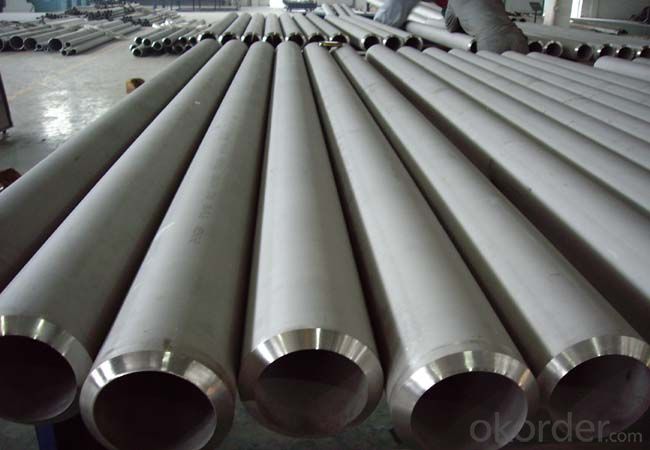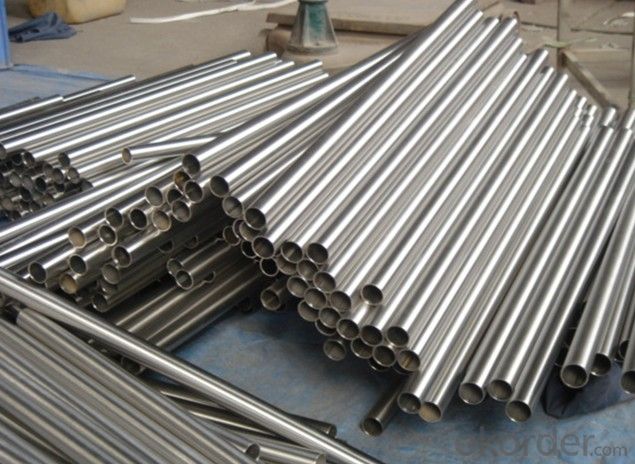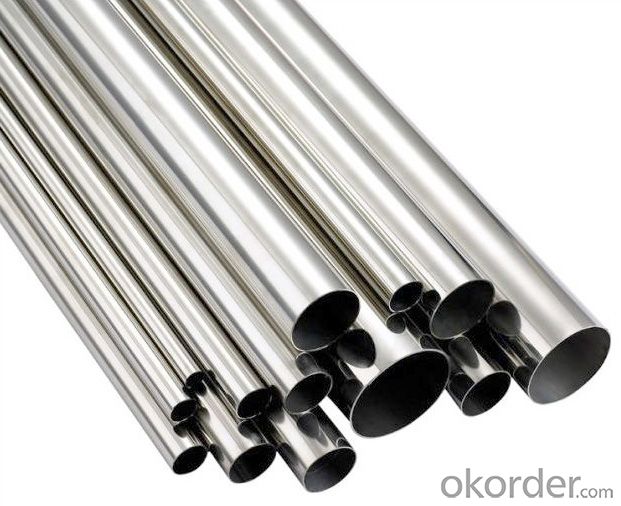Sales of Various Models for the Stainless Steel Pipe
- Loading Port:
- Tianjin
- Payment Terms:
- TT or LC
- Min Order Qty:
- 30 m.t.
- Supply Capability:
- 4000 m.t./month
OKorder Service Pledge
OKorder Financial Service
You Might Also Like
1、Structure of Heat Exchanger Stainless Steel Pipe TP304 ASTM A213 Description:
Boiler Heat Exchange stainless steel pipe is often used in the heating system. Heating system, or those stored energy (such as solar energy) in the form of heat, need to be built with the material that can withstand temperatures up to 550 degrees Celsius. High chromium molybdenum welded steel pipe can work in the extreme, which maintain as the ideal material for the construction of power station.
2、Main Features of Heat Exchanger Stainless Steel Pipe TP304 ASTM A213:
• High manufacturing accuracy
• High strength
• Small inertia resistance
• Strong heat dissipation ability
• Good visual effect
•Reasonable price
3、Heat Exchanger Stainless Steel Pipe TP304 ASTM A213 Specification:
1)Commodity: heat exchanger pipe
2))Material: 304,316L,304L,316,321,310S,etc
3)Thickness:0.5-100mm
4)Length: 1-14m
| Material Grade | 304,304L,316 ,316L,321,310S,2205,904and so on. |
| Standard | ASTM A312, A554, A249, A269 and A270,ect |
| DIN 17456-85 , DIN 17458-85, DIN 17459-92,ect | |
| JIS G3446-1994, JIS G3448-1997, JIS G3459-1997, JIS G3463-1994,ect | |
| GB13296-1991, GB14975-2002, GB14976-2002,ect | |
| Outer Diameter | 13.7-2020mm |
| Thickness | 0.5-50mm |
| Length | 1m -12m or as customers' request |
| Polish | 180G, 320G, 400G Satin / Hairline |
| 400G, 500G, 600G or 800G Mirror finish | |
| Test | eddy current inspection, ultrasonic inspection, X-ray inspection, real-time imaging, hydrostatic test, spectral analysis, intergranular corrosion, water pressure test, and mechanical property testing facilities. |
| Payment | 1) by L/C at sight, |
| 2) 30% deposit, 70% balance before Shipping. | |
| Delivery time | A.7 days if this goods is stock goods. |
| B.25 days if this goods will be produced after order | |
| Validity | Valid time is 3 days for price usually. |
| Payment terms | FOB QINGDAO |
| MOQ | 1 ton |
| Capacity | 1000 ton per month |
| Certificate | ISO, SGS, and third part inspection |
| Applications | the products are widely used in chemical industry, condenser pipe, heat exchanger, petroleum, shipping military, environment protection, high temperature resistant, low temperature resistant, corrosion resistant and so on. |
| packing details | 1) Wooden-box Package. 2) The Wooden Frame Packing. 3) Intertexture Cloth Packaging with the Iron Sheet Bonding and the Two Terminals Covered With Plastic Dome. |
4、Heat Exchanger Stainless Steel Pipe TP304 ASTM A213 Images:



5、FAQ of Heat Exchanger Stainless Steel Pipe TP304 ASTM A213:
①How is the quality of your products?
Our products are manufactured strictly according to national and internaional standard, and we take a test on every pipe before delivered out. If you want see our quality certifications and all kinds of testing report, please just ask us for it.
Guaranteed: If products’ quality don’t accord to discription as we give or the promise before you place order, we promise 100% refund.
②How about price?
Yes, we are factory and be able to give you lowest price below market one, and we have a policy that “ for saving time and absolutely honest business attitude, we quote as lowest as possible for any customer, and discount can be given according to quantity”,if you like bargain and factory price is not low enough as you think, just don’t waste your time.Please trust the quotation we would give you, it is professional one.
③Why should you chose us?
Chose happens because of quality, then price, We can give you both.Additionally, we can also offer professional products inquiry, products knowledge train(for agents), smooth goods delivery, exellent customer solution proposals.Our service formula: good quality+good price+good service=customer’s trust
SGS test is available, customer inspection before shipping is welcome, third party inspection is no problem.
Any question, pls feel free to contact us !
- Q:Are stainless steel pipes suitable for high-pressure steam applications?
- Yes, stainless steel pipes are suitable for high-pressure steam applications. Stainless steel has excellent corrosion resistance, high-temperature strength, and durability, making it a suitable material choice for handling high-pressure steam.
- Q:What are the weight limitations for stainless steel pipes?
- The weight restrictions of stainless steel pipes differ based on multiple factors, including the stainless steel grade, pipe dimensions, and intended usage. Nevertheless, stainless steel pipes are renowned for their robustness and endurance, enabling them to endure substantial loads. Generally, stainless steel pipes possess the capacity to bear significant weight without distorting or collapsing. To obtain precise weight limitations tailored to the specific type and size of stainless steel pipe employed, it is crucial to refer to the manufacturer's specifications or engineering standards, as they offer the most accurate information.
- Q:What is the difference between ferritic and austenitic stainless steel pipes?
- Ferritic and austenitic stainless steel pipes differ primarily in their microstructure and composition, resulting in distinct properties and applications. Ferritic stainless steel pipes are characterized by a ferrite microstructure, which is a body-centered cubic crystal structure. They contain high levels of chromium (typically around 10-30%) and low levels of carbon. Due to their low carbon content, ferritic stainless steel pipes have excellent corrosion resistance but are prone to sensitization and intergranular corrosion at high temperatures. They also possess good durability, heat resistance, and magnetic properties, making them suitable for applications such as automotive exhaust systems, architectural structures, and heat exchangers. On the other hand, austenitic stainless steel pipes have an austenite microstructure, which is a face-centered cubic crystal structure. They contain high levels of chromium (typically around 16-26%) and nickel (usually 6-22%), along with low carbon content. Austenitic stainless steel pipes exhibit superior corrosion resistance, even in highly aggressive environments. Their non-magnetic nature, excellent ductility, and high toughness make them ideal for various industries, including chemical processing, food and beverage, pharmaceuticals, and medical equipment manufacturing. Austenitic stainless steel pipes are also less prone to sensitization and intergranular corrosion compared to ferritic stainless steel pipes. In summary, ferritic stainless steel pipes have a ferrite microstructure, good corrosion resistance, and magnetic properties, while austenitic stainless steel pipes have an austenite microstructure, superior corrosion resistance, non-magnetic properties, and enhanced mechanical properties. The choice between ferritic and austenitic stainless steel pipes depends on the specific application, desired properties, and environmental conditions.
- Q:Are stainless steel pipes suitable for drinking water applications?
- Yes, stainless steel pipes are suitable for drinking water applications. Stainless steel is highly resistant to corrosion, which ensures the water remains free from contaminants. It also has a smooth surface that prevents the accumulation of bacteria or impurities, making it a safe and hygienic choice for transporting drinking water.
- Q:Are stainless steel pipes resistant to sea water corrosion?
- Yes, stainless steel pipes are highly resistant to sea water corrosion. Stainless steel is known for its exceptional corrosion resistance, making it an ideal material for various applications, including pipes used in marine environments. The high levels of chromium and nickel present in stainless steel create a protective layer on the surface of the metal, preventing corrosion and damage from exposure to sea water. Additionally, stainless steel pipes are also resistant to other forms of corrosion, such as rusting and pitting, which further enhances their durability and longevity in marine environments. Therefore, stainless steel pipes are a reliable choice for applications that involve contact with sea water.
- Q:How do stainless steel pipes compare to other materials like carbon steel or PVC?
- Stainless steel pipes have several advantages over other materials like carbon steel or PVC when it comes to various applications. Firstly, stainless steel pipes are renowned for their excellent corrosion resistance. They are resistant to rust, oxidation, and staining, making them suitable for use in environments with high moisture or chemical exposure. In contrast, carbon steel pipes are susceptible to corrosion and require protective coatings to prevent rusting, while PVC pipes are not resistant to certain chemicals and can degrade over time. Secondly, stainless steel pipes offer exceptional strength and durability. They can withstand high pressure and extreme temperatures, making them ideal for applications that require robust and long-lasting piping systems. Carbon steel pipes also possess good strength characteristics, but they may not be as resistant to corrosion as stainless steel. On the other hand, PVC pipes are relatively weaker and may not be suitable for high-pressure applications. Furthermore, stainless steel pipes have excellent hygienic properties. They are non-porous, smooth, and easy to clean, making them suitable for use in industries such as food and beverage, pharmaceuticals, and healthcare, where maintaining cleanliness and preventing bacterial growth is crucial. Carbon steel pipes, due to their porous nature, can accumulate contaminants and bacteria over time. PVC pipes, although easy to clean, may release certain chemicals into the water or fluids passing through them, which can be a concern in certain applications. Lastly, stainless steel pipes are highly versatile. They can be used in a wide range of applications, including water supply, gas pipelines, chemical processing, oil and gas exploration, and architectural purposes. Carbon steel pipes are also versatile but may require additional measures to prevent corrosion. PVC pipes, while suitable for certain applications, have limitations in terms of temperature and pressure ratings. Overall, stainless steel pipes offer superior corrosion resistance, strength, durability, and hygienic properties compared to carbon steel or PVC pipes. When choosing a piping material, it is essential to consider the specific requirements of the application to ensure optimal performance and longevity.
- Q:What are the common industry standards for stainless steel pipes?
- The recommended standards for stainless steel pipes differ depending on the intended use and the regulations of each country. Nonetheless, there are several widely recognized and accepted standards, such as those established by the ASTM, ASME, and ISO. The ASTM standards, like ASTM A312 and ASTM A269, provide guidelines for the production and quality control of stainless steel pipes. These standards cover various aspects, including the chemical composition, mechanical properties, dimensions, and tolerances. The ASME standards, particularly ASME B36.19 and ASME B36.10M, specify the dimensions and wall thicknesses of stainless steel pipes for specific applications. Additionally, ASME B31.3 offers guidelines for the design, construction, and maintenance of process piping systems that may incorporate stainless steel pipes. The ISO standards, such as ISO 1127 and ISO 2037, establish international guidelines for the dimensions, tolerances, and surface finishes of stainless steel pipes. These standards ensure that stainless steel pipes can be used interchangeably and are compatible across different countries. Furthermore, specific industries may have their own requirements. For instance, the food and beverage industry often follows the standards set by organizations like 3-A Sanitary Standards, which emphasize the cleanliness and hygiene of stainless steel pipes used in food processing. It is crucial to consult the relevant standards and regulations for each specific application to ensure compliance with industry requirements and to guarantee the safe and efficient use of stainless steel pipes.
- Q:How do you prevent vibration in stainless steel pipes?
- To prevent vibration in stainless steel pipes, various measures can be taken: 1. Employ suitable pipe supports: It is imperative to carefully select and install appropriate pipe supports. These supports should be designed to offer ample stability and rigidity to the pipe system, minimizing any potential movement or vibration. 2. Mitigate vibrations with isolators: Strategic placement of vibration isolators along the pipe system can help absorb and dampen vibrations. This reduces the transmission of vibrations through the stainless steel pipes. 3. Ensure proper pipe alignment: During installation, ensure that the pipes are aligned correctly. Misalignment can lead to stress concentrations and heightened vibration. Proper alignment helps distribute forces evenly and reduces vibration. 4. Decrease fluid velocity: High fluid velocities can induce turbulence and vibrations in the pipe system. By reducing the fluid velocity, either through adjusting the flow rate or utilizing flow control devices like throttling valves, vibrations can be minimized. 5. Implement soundproofing measures: In certain cases, vibrations may be caused by external factors, such as nearby machinery or equipment. To reduce noise and vibrations originating from these sources, consider implementing soundproofing measures like using noise-absorbing materials or installing vibration-blocking barriers. 6. Regularly maintain and inspect the pipe system: Conduct routine inspections to detect any signs of vibration or wear in the pipe system. Address any issues promptly to prevent further vibration problems. Additionally, ensure proper maintenance of the pipe system, including regular cleaning and lubrication of any moving parts. By implementing these measures, vibration in stainless steel pipes can be effectively prevented, ensuring the overall stability and integrity of the pipe system.
- Q:How do you prevent contamination in stainless steel pipes?
- To prevent contamination in stainless steel pipes, proper cleaning and maintenance practices should be followed. This includes regular inspection and removal of any buildup or deposits, ensuring that the pipes are properly sealed to prevent ingress of contaminants, and avoiding contact with substances that can cause corrosion or contamination. Additionally, implementing a proper filtration system and adhering to recommended hygiene protocols can further prevent contamination in stainless steel pipes.
- Q:Can stainless steel pipes be used for chemical storage tanks?
- Yes, stainless steel pipes can be used for chemical storage tanks. Stainless steel is highly resistant to corrosion and can withstand the harsh chemicals found in many industrial processes. Additionally, stainless steel pipes are durable, easy to clean, and have a long lifespan, making them a suitable choice for chemical storage applications.
1. Manufacturer Overview |
|
|---|---|
| Location | |
| Year Established | |
| Annual Output Value | |
| Main Markets | |
| Company Certifications | |
2. Manufacturer Certificates |
|
|---|---|
| a) Certification Name | |
| Range | |
| Reference | |
| Validity Period | |
3. Manufacturer Capability |
|
|---|---|
| a)Trade Capacity | |
| Nearest Port | |
| Export Percentage | |
| No.of Employees in Trade Department | |
| Language Spoken: | |
| b)Factory Information | |
| Factory Size: | |
| No. of Production Lines | |
| Contract Manufacturing | |
| Product Price Range | |
Send your message to us
Sales of Various Models for the Stainless Steel Pipe
- Loading Port:
- Tianjin
- Payment Terms:
- TT or LC
- Min Order Qty:
- 30 m.t.
- Supply Capability:
- 4000 m.t./month
OKorder Service Pledge
OKorder Financial Service
Similar products
New products
Hot products
Hot Searches
Related keywords





























